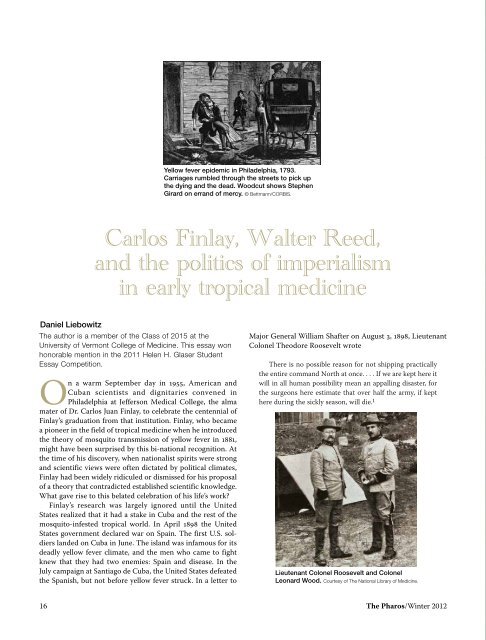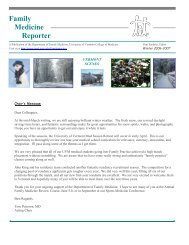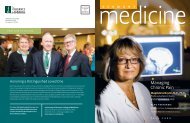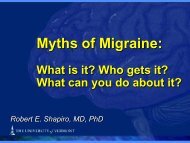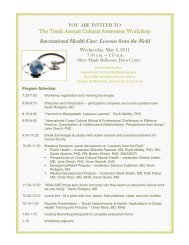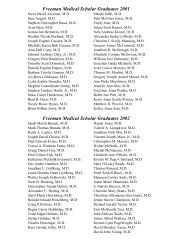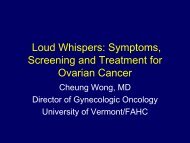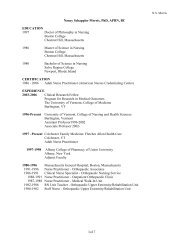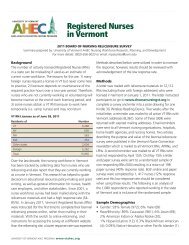Carlos Finlay, Walter Reed, and the politics of imperialism in early ...
Carlos Finlay, Walter Reed, and the politics of imperialism in early ...
Carlos Finlay, Walter Reed, and the politics of imperialism in early ...
You also want an ePaper? Increase the reach of your titles
YUMPU automatically turns print PDFs into web optimized ePapers that Google loves.
Daniel Liebowitz<br />
The author is a member <strong>of</strong> <strong>the</strong> Class <strong>of</strong> 2015 at <strong>the</strong><br />
University <strong>of</strong> Vermont College <strong>of</strong> Medic<strong>in</strong>e. This essay won<br />
honorable mention <strong>in</strong> <strong>the</strong> 2011 Helen H. Glaser Student<br />
Essay Competition.<br />
Yellow fever epidemic <strong>in</strong> Philadelphia, 1793.<br />
Carriages rumbled through <strong>the</strong> streets to pick up<br />
<strong>the</strong> dy<strong>in</strong>g <strong>and</strong> <strong>the</strong> dead. Woodcut shows Stephen<br />
Girard on err<strong>and</strong> <strong>of</strong> mercy. © Bettmann/CORBIS.<br />
<strong>Carlos</strong> <strong>F<strong>in</strong>lay</strong>, <strong>Walter</strong> <strong>Reed</strong>,<br />
<strong>and</strong> <strong>the</strong> <strong>politics</strong> <strong>of</strong> <strong>imperialism</strong><br />
<strong>in</strong> <strong>early</strong> tropical medic<strong>in</strong>e<br />
On a warm September day <strong>in</strong> 1955, American <strong>and</strong><br />
Cuban scientists <strong>and</strong> dignitaries convened <strong>in</strong><br />
Philadelphia at Jefferson Medical College, <strong>the</strong> alma<br />
mater <strong>of</strong> Dr. <strong>Carlos</strong> Juan <strong>F<strong>in</strong>lay</strong>, to celebrate <strong>the</strong> centennial <strong>of</strong><br />
<strong>F<strong>in</strong>lay</strong>’s graduation from that <strong>in</strong>stitution. <strong>F<strong>in</strong>lay</strong>, who became<br />
a pioneer <strong>in</strong> <strong>the</strong> field <strong>of</strong> tropical medic<strong>in</strong>e when he <strong>in</strong>troduced<br />
<strong>the</strong> <strong>the</strong>ory <strong>of</strong> mosquito transmission <strong>of</strong> yellow fever <strong>in</strong> 1881,<br />
might have been surprised by this bi-national recognition. At<br />
<strong>the</strong> time <strong>of</strong> his discovery, when nationalist spirits were strong<br />
<strong>and</strong> scientific views were <strong>of</strong>ten dictated by political climates,<br />
<strong>F<strong>in</strong>lay</strong> had been widely ridiculed or dismissed for his proposal<br />
<strong>of</strong> a <strong>the</strong>ory that contradicted established scientific knowledge.<br />
What gave rise to this belated celebration <strong>of</strong> his life’s work?<br />
<strong>F<strong>in</strong>lay</strong>’s research was largely ignored until <strong>the</strong> United<br />
States realized that it had a stake <strong>in</strong> Cuba <strong>and</strong> <strong>the</strong> rest <strong>of</strong> <strong>the</strong><br />
mosquito-<strong>in</strong>fested tropical world. In April 1898 <strong>the</strong> United<br />
States government declared war on Spa<strong>in</strong>. The first U.S. soldiers<br />
l<strong>and</strong>ed on Cuba <strong>in</strong> June. The isl<strong>and</strong> was <strong>in</strong>famous for its<br />
deadly yellow fever climate, <strong>and</strong> <strong>the</strong> men who came to fight<br />
knew that <strong>the</strong>y had two enemies: Spa<strong>in</strong> <strong>and</strong> disease. In <strong>the</strong><br />
July campaign at Santiago de Cuba, <strong>the</strong> United States defeated<br />
<strong>the</strong> Spanish, but not before yellow fever struck. In a letter to<br />
Major General William Shafter on August 3, 1898, Lieutenant<br />
Colonel Theodore Roosevelt wrote<br />
There is no possible reason for not shipp<strong>in</strong>g practically<br />
<strong>the</strong> entire comm<strong>and</strong> North at once. . . . If we are kept here it<br />
will <strong>in</strong> all human possibility mean an appall<strong>in</strong>g disaster, for<br />
<strong>the</strong> surgeons here estimate that over half <strong>the</strong> army, if kept<br />
here dur<strong>in</strong>g <strong>the</strong> sickly season, will die. 1<br />
Lieutenant Colonel Roosevelt <strong>and</strong> Colonel<br />
Leonard Wood. Courtesy <strong>of</strong> The National Library <strong>of</strong> Medic<strong>in</strong>e.<br />
16 The Pharos/W<strong>in</strong>ter 2012
Aedes aegypti. Right, Dr.<br />
<strong>Carlos</strong> J. <strong>F<strong>in</strong>lay</strong><br />
Courtesy <strong>of</strong> <strong>the</strong> National Library <strong>of</strong><br />
Medic<strong>in</strong>e.<br />
The Pharos/W<strong>in</strong>ter 2012 17
<strong>Carlos</strong> <strong>F<strong>in</strong>lay</strong>, <strong>Walter</strong> <strong>Reed</strong>, <strong>and</strong> <strong>the</strong> <strong>politics</strong> <strong>of</strong> <strong>imperialism</strong> <strong>in</strong> <strong>early</strong> tropical medic<strong>in</strong>e<br />
The Prado <strong>in</strong> Havana <strong>in</strong> 1899. Courtesy <strong>of</strong> <strong>the</strong> Historical Collections & Services, Claude Moore Health Services Library, University <strong>of</strong> Virg<strong>in</strong>ia.<br />
Roosevelt’s plea came too late; n<strong>early</strong> 2,000 men contracted<br />
yellow fever <strong>in</strong> that camp. The disease’s devastation to <strong>the</strong><br />
U.S. Army spurred <strong>the</strong> creation <strong>in</strong> June 1900 <strong>of</strong> <strong>the</strong> U.S. Army<br />
Yellow Fever Commission, presided over by Major <strong>Walter</strong><br />
<strong>Reed</strong>. The Commission eventually was successful <strong>in</strong> confirm<strong>in</strong>g<br />
<strong>the</strong> <strong>the</strong>ory <strong>of</strong> mosquito transmission <strong>of</strong> yellow fever <strong>and</strong><br />
used this knowledge to eradicate <strong>the</strong> disease first from Havana<br />
<strong>and</strong> <strong>the</strong>n from o<strong>the</strong>r newly acquired American territorial<br />
possessions. But <strong>the</strong> studies on yellow fever at <strong>the</strong> turn <strong>of</strong> <strong>the</strong><br />
twentieth century were <strong>in</strong>separably <strong>in</strong>tertw<strong>in</strong>ed with <strong>the</strong> <strong>politics</strong><br />
<strong>of</strong> nationalism <strong>and</strong> <strong>imperialism</strong>.<br />
When <strong>F<strong>in</strong>lay</strong> began his research on yellow fever <strong>in</strong> <strong>the</strong><br />
1870s, very little was known about this mysterious disease.<br />
Endemic <strong>in</strong> Cuba, it caused great morbidity <strong>in</strong> <strong>the</strong> native-born<br />
<strong>in</strong>fected <strong>in</strong> childhood <strong>and</strong> great mortality <strong>in</strong> immigrants who<br />
lacked immunity. In <strong>the</strong> United States, where <strong>the</strong> climate was<br />
cooler, yellow fever struck <strong>in</strong> waves <strong>of</strong> periodic epidemics. In<br />
1878 a widespread epidemic hit more than 100 U.S. cities from<br />
<strong>the</strong> Deep South to as far north as Ohio. An estimated 120,000<br />
cases <strong>of</strong> yellow fever <strong>and</strong> 20,000 deaths crippled commerce<br />
<strong>and</strong> had enormous f<strong>in</strong>ancial costs. The disease struck people<br />
<strong>of</strong> all races, ages, <strong>and</strong> social backgrounds, <strong>and</strong> traditional efforts<br />
<strong>of</strong> quarant<strong>in</strong>e <strong>and</strong> sanitation were fruitless. When <strong>the</strong><br />
epidemic subsided as w<strong>in</strong>ter approached, <strong>the</strong> nation blamed<br />
<strong>the</strong> yellow fever epidemic on poor sanitation <strong>in</strong> <strong>the</strong> South <strong>and</strong><br />
recommended isolat<strong>in</strong>g <strong>the</strong> epidemic states to punish <strong>the</strong>m for<br />
<strong>the</strong>ir so-called “filthy liv<strong>in</strong>g.” 2p60<br />
Despite <strong>the</strong> terror <strong>and</strong> devastation that <strong>the</strong> 1878 outbreak<br />
caused throughout <strong>the</strong> sou<strong>the</strong>rn United States, after <strong>the</strong> epidemic<br />
subsided <strong>the</strong> U.S. government <strong>and</strong> public were largely<br />
satisfied to get on with bus<strong>in</strong>ess as usual <strong>and</strong> accept that periodic<br />
epidemics were a way <strong>of</strong> life. Lack <strong>of</strong> adequate fund<strong>in</strong>g <strong>in</strong><br />
<strong>the</strong> South, where yellow fever was most likely to strike aga<strong>in</strong>,<br />
<strong>and</strong> apathy from <strong>the</strong> rest <strong>of</strong> <strong>the</strong> country, where yellow fever<br />
was not a direct problem, meant scientific research on <strong>the</strong><br />
disease ga<strong>in</strong>ed very little support. The prevail<strong>in</strong>g scientific<br />
<strong>the</strong>ories on <strong>the</strong> contagion <strong>of</strong> <strong>in</strong>fectious diseases attributed yellow<br />
fever to ei<strong>the</strong>r miasma (a filth <strong>in</strong> <strong>the</strong> atmosphere) or fomites<br />
(disease-<strong>in</strong>fected cloth<strong>in</strong>g <strong>and</strong> material). Americans were<br />
confident that sanitary reform that removed <strong>the</strong>se sources <strong>of</strong><br />
disease <strong>and</strong> isolated <strong>the</strong> sick from <strong>the</strong> healthy would stave <strong>of</strong>f<br />
fur<strong>the</strong>r epidemics or at least protect <strong>the</strong> wealthy <strong>and</strong> powerful<br />
from <strong>the</strong> sickly <strong>and</strong> “morally depraved” poor. 2p61<br />
Unlike <strong>in</strong> <strong>the</strong> United States where yellow fever was an<br />
<strong>in</strong>termittent unwelcome visitor, <strong>in</strong> Cuba <strong>the</strong> disease was a<br />
constant presence. Most Cubans acquired <strong>the</strong> disease <strong>in</strong><br />
childhood, leav<strong>in</strong>g survivors with protective immunity. Yellow<br />
fever was less k<strong>in</strong>d to foreign visitors or immigrants. As a<br />
Spanish colony, Cuba attracted many Spaniards both civilian<br />
<strong>and</strong> military. Yellow fever killed enough Spaniards to earn <strong>the</strong><br />
nickname <strong>the</strong> “undaunted plague <strong>of</strong> foreign visitors” <strong>and</strong> <strong>the</strong><br />
“greatest enemy <strong>of</strong> Spanish soldiers.” 3p78 It was <strong>in</strong> this disease<br />
climate that <strong>Carlos</strong> <strong>F<strong>in</strong>lay</strong> began his research.<br />
<strong>F<strong>in</strong>lay</strong>, born <strong>in</strong> 1833 <strong>in</strong> Camagüey, Cuba, to a Scottish fa<strong>the</strong>r<br />
<strong>and</strong> a French mo<strong>the</strong>r, completed his medical tra<strong>in</strong><strong>in</strong>g <strong>in</strong><br />
Philadelphia at Jefferson Medical College <strong>and</strong> returned to his<br />
native Cuba to practice <strong>and</strong> study yellow fever. He <strong>in</strong>itially accepted<br />
<strong>the</strong> exist<strong>in</strong>g climate-miasma <strong>the</strong>ory, which attributed<br />
<strong>the</strong> yellow fever climate <strong>in</strong> Cuba to chemicals <strong>in</strong> <strong>the</strong> air that<br />
created an alkal<strong>in</strong>e atmosphere, but by <strong>the</strong> 1870s he began<br />
to notice compell<strong>in</strong>g correlations between <strong>the</strong> prevalence<br />
<strong>of</strong> mosquitoes <strong>and</strong> <strong>the</strong> severity <strong>of</strong> yellow fever epidemics.<br />
In addition to mak<strong>in</strong>g epidemiological <strong>and</strong> meteorological<br />
observations, he devised a method <strong>of</strong> <strong>in</strong>oculat<strong>in</strong>g humans<br />
18 The Pharos/W<strong>in</strong>ter 2012
Political cartoon <strong>of</strong> 1878, “Shall We Let Him In? Mr.<br />
Mayor <strong>and</strong> gentlemen <strong>of</strong> <strong>the</strong> Board <strong>of</strong> Aldermen, <strong>the</strong><br />
answer rests with you.” © Bettman/CORBIS<br />
with <strong>in</strong>fected mosquitoes to test his <strong>the</strong>ory. In 1881 he presented<br />
his first paper on <strong>the</strong> subject to <strong>the</strong> Royal Academy<br />
<strong>of</strong> Medical, Physical <strong>and</strong> Natural Sciences <strong>in</strong> Havana <strong>and</strong> <strong>the</strong><br />
International Sanitary Conference <strong>in</strong> Wash<strong>in</strong>gton, D.C., titled,<br />
“The Mosquito Hypo<strong>the</strong>tically Considered as <strong>the</strong> Agent <strong>of</strong><br />
Transmission <strong>of</strong> Yellow Fever.” He began by stat<strong>in</strong>g<br />
I feel conv<strong>in</strong>ced that any <strong>the</strong>ory which attributes <strong>the</strong> orig<strong>in</strong><br />
<strong>and</strong> propagation <strong>of</strong> yellow fever to atmospheric <strong>in</strong>fluences,<br />
to miasmatic or meteorological conditions, to filth or to <strong>the</strong><br />
neglect <strong>of</strong> general hygienic precautions, must be considered<br />
as utterly <strong>in</strong>defensible. 4p27<br />
<strong>F<strong>in</strong>lay</strong> argued that<br />
<strong>the</strong> meteorological conditions which are most favorable to<br />
<strong>the</strong> development <strong>of</strong> yellow fever are those which contribute<br />
to <strong>in</strong>crease <strong>the</strong> number <strong>of</strong> mosquitoes. 4p40<br />
At this <strong>early</strong> stage <strong>in</strong> his research he had only made five attempted<br />
<strong>in</strong>oculations, which had resulted <strong>in</strong> one mild case <strong>of</strong><br />
yellow fever, two abortive cases <strong>in</strong> which yellow fever was not<br />
apparent but immunity seemed to result, <strong>and</strong> two cases <strong>of</strong> a<br />
nondescript, or as he called it, ephemeral fever. He concluded<br />
These experiments are certa<strong>in</strong>ly favorable to my <strong>the</strong>ory, but<br />
I do not wish to exaggerate <strong>the</strong>ir value <strong>in</strong> consider<strong>in</strong>g <strong>the</strong>m<br />
f<strong>in</strong>al . . . I underst<strong>and</strong> but too well that noth<strong>in</strong>g less than an<br />
absolutely <strong>in</strong>controvertible demonstration will be required<br />
About Daniel Liebowitz<br />
I graduated from Vassar College <strong>in</strong><br />
2010 with a major <strong>in</strong> history <strong>and</strong> a m<strong>in</strong>or<br />
<strong>in</strong> chemistry. I am currently a secondyear<br />
medical student at <strong>the</strong> University <strong>of</strong><br />
Vermont College <strong>of</strong> Medic<strong>in</strong>e. I am <strong>in</strong>terested<br />
<strong>in</strong> <strong>in</strong>ternal medic<strong>in</strong>e <strong>and</strong> <strong>in</strong>fectious<br />
disease, but cont<strong>in</strong>ue to explore my <strong>in</strong>terest <strong>in</strong> <strong>the</strong><br />
history <strong>of</strong> medic<strong>in</strong>e to help me underst<strong>and</strong> how <strong>the</strong><br />
pr<strong>of</strong>ession has progressed to its modern manifestation.<br />
I also enjoy runn<strong>in</strong>g, cycl<strong>in</strong>g, <strong>and</strong> explor<strong>in</strong>g <strong>the</strong><br />
outdoors <strong>in</strong> my spare time.<br />
before <strong>the</strong> generality <strong>of</strong> my colleagues accept a <strong>the</strong>ory so<br />
entirely at variance with <strong>the</strong> ideas which have until now<br />
prevailed about yellow-fever. 4p42<br />
He asked that his colleagues observe his epidemiological <strong>and</strong><br />
experimental evidence <strong>and</strong> consider its merits. S<strong>in</strong>ce <strong>the</strong> exist<strong>in</strong>g<br />
<strong>the</strong>ories had proven to be useless, <strong>the</strong> mosquito-transmission<br />
<strong>the</strong>ory could lead to control <strong>of</strong> <strong>the</strong> disease.<br />
From 1881 to <strong>the</strong> end <strong>of</strong> <strong>the</strong> century <strong>F<strong>in</strong>lay</strong> proceeded with<br />
his mosquito <strong>in</strong>oculation experiments, cont<strong>in</strong>u<strong>in</strong>g to publish<br />
<strong>and</strong> present his mount<strong>in</strong>g evidence <strong>of</strong> <strong>the</strong> correctness <strong>of</strong> his<br />
<strong>the</strong>ory. Unfortunately, because his <strong>in</strong>oculations had limited<br />
success (<strong>of</strong> 90 <strong>in</strong>dividuals <strong>in</strong>oculated by 1894, he had only a<br />
few positive results), <strong>the</strong> scientific community <strong>in</strong> Cuba <strong>and</strong><br />
abroad underst<strong>and</strong>ably cont<strong>in</strong>ued to be skeptical. Despite<br />
shortcom<strong>in</strong>gs <strong>in</strong> his research, <strong>F<strong>in</strong>lay</strong>’s astute observations on<br />
<strong>the</strong> habits <strong>of</strong> mosquitoes <strong>and</strong> <strong>the</strong> spatial <strong>and</strong> temporal distribution<br />
<strong>of</strong> yellow fever resulted <strong>in</strong> his identification <strong>of</strong> <strong>the</strong> sole<br />
carrier, <strong>the</strong> mosquito, <strong>and</strong> <strong>the</strong> primary species, Culex fasciatus<br />
(now called Aedes aegypti).<br />
<strong>F<strong>in</strong>lay</strong> did not give up on support<strong>in</strong>g his <strong>the</strong>ory, nor did<br />
he neglect to devise public health solutions based on his<br />
research. As <strong>early</strong> as 1898 he proposed practical methods to<br />
eradicate yellow fever that ultimately were used by <strong>the</strong> U.S.<br />
Army sanitarian Major William Crawford Gorgas after 1901.<br />
<strong>F<strong>in</strong>lay</strong> wrote,<br />
Why should not <strong>the</strong> houses <strong>in</strong> yellow fever countries be<br />
provided with mosquito bl<strong>in</strong>ds, such as are used <strong>in</strong> <strong>the</strong><br />
United States as a mere matter <strong>of</strong> comfort, whereas it might<br />
be a question <strong>of</strong> life or death? The mosquito larvae might be<br />
destroyed <strong>in</strong> swamps, pools, privies, s<strong>in</strong>ks, street-sewers <strong>and</strong><br />
o<strong>the</strong>r stagnant waters, where <strong>the</strong>y are bred, by a methodical<br />
use <strong>of</strong> permanganate <strong>of</strong> potassium. . . . But <strong>the</strong> most essential<br />
po<strong>in</strong>t must be to prevent those <strong>in</strong>sects from reach<strong>in</strong>g<br />
yellow fever patients. 5p354<br />
The Pharos/W<strong>in</strong>ter 2012 19
<strong>Carlos</strong> <strong>F<strong>in</strong>lay</strong>, <strong>Walter</strong> <strong>Reed</strong>, <strong>and</strong> <strong>the</strong> <strong>politics</strong> <strong>of</strong> <strong>imperialism</strong> <strong>in</strong> <strong>early</strong> tropical medic<strong>in</strong>e<br />
<strong>F<strong>in</strong>lay</strong> had, <strong>in</strong> <strong>the</strong> twenty years before <strong>the</strong> U.S. Army Yellow<br />
Fever Commission was established, observed or tested most <strong>of</strong><br />
<strong>the</strong> “discoveries” <strong>the</strong> commission touted as its own. To underst<strong>and</strong><br />
<strong>the</strong> historical progression from <strong>the</strong> dismissal <strong>of</strong> <strong>F<strong>in</strong>lay</strong>’s<br />
work to U.S. Army scientists ga<strong>in</strong><strong>in</strong>g world recognition for<br />
cont<strong>in</strong>u<strong>in</strong>g what <strong>F<strong>in</strong>lay</strong> had started, it is important to trace <strong>the</strong><br />
scientific <strong>and</strong> political <strong>in</strong>terests <strong>of</strong> <strong>the</strong> United States <strong>in</strong> Cuba.<br />
In 1881, when <strong>F<strong>in</strong>lay</strong> first proposed his <strong>the</strong>ory, <strong>the</strong> concept<br />
<strong>of</strong> <strong>in</strong>sect vectors <strong>of</strong> disease was still very new. In 1879 Patrick<br />
Manson <strong>of</strong> Engl<strong>and</strong> observed that mosquitoes were <strong>the</strong> <strong>in</strong>termediate<br />
host <strong>of</strong> <strong>the</strong> filarial worm <strong>of</strong> <strong>the</strong> disease elephantiasis,<br />
but even <strong>the</strong>n did not claim that disease could be passed<br />
directly from <strong>the</strong> mosquito to <strong>the</strong> human host. It was not<br />
until 1898 <strong>and</strong> Ronald Ross’s work on malaria that <strong>the</strong> <strong>the</strong>ory<br />
<strong>of</strong> direct mosquito-human transmission began to be widely<br />
accepted. 6<br />
The political climate <strong>in</strong> Cuba <strong>and</strong> <strong>the</strong> country’s tenuous<br />
relationship with both Spa<strong>in</strong> <strong>and</strong> <strong>the</strong> United States no doubt<br />
negatively affected <strong>F<strong>in</strong>lay</strong>’s research <strong>and</strong> his legitimacy. Social<br />
<strong>and</strong> political strife def<strong>in</strong>ed Cuban affairs, penetrat<strong>in</strong>g even<br />
to <strong>the</strong> disruption <strong>of</strong> academic <strong>and</strong> scientific research. After<br />
<strong>the</strong> unsuccessful bid for <strong>in</strong>dependence from Spa<strong>in</strong> <strong>in</strong> <strong>the</strong> Ten<br />
Years War <strong>of</strong> 1868 to 1878, <strong>the</strong> Cuban economy <strong>and</strong> <strong>the</strong> value<br />
<strong>of</strong> sugar crashed toge<strong>the</strong>r as Spa<strong>in</strong> attempted to make Cuba<br />
pay for <strong>the</strong> war debt. Unemployment was high <strong>and</strong> large urban<br />
migrations led to dangerous overcrowd<strong>in</strong>g <strong>in</strong> <strong>the</strong> cities.<br />
Many white middle-class creoles like <strong>F<strong>in</strong>lay</strong> had <strong>the</strong>ir property<br />
confiscated <strong>and</strong> jobs replaced by <strong>the</strong> hundreds <strong>of</strong> thous<strong>and</strong>s<br />
<strong>of</strong> Spanish immigrants who flooded <strong>in</strong>to Cuba, seek<strong>in</strong>g a better<br />
life <strong>in</strong> <strong>the</strong> New World. Many disgruntled creole Cubans<br />
became adamant supporters <strong>of</strong> separation from Spa<strong>in</strong> <strong>and</strong><br />
turned to <strong>the</strong> United States for both economic <strong>and</strong> political<br />
support. Cuban planters became <strong>in</strong>creas<strong>in</strong>gly reliant on<br />
<strong>the</strong> United States as U.S. capital penetrated deeper <strong>in</strong>to <strong>the</strong><br />
Cuban economy, <strong>and</strong> many even became advocates <strong>of</strong> U.S.<br />
<strong>in</strong>tervention. 7<br />
As U.S. f<strong>in</strong>ancial <strong>in</strong>terests <strong>in</strong> Cuba grew <strong>and</strong> Spanish control<br />
over <strong>the</strong> isl<strong>and</strong> decl<strong>in</strong>ed, <strong>the</strong> United States began to recognize<br />
that it needed to exercise more <strong>in</strong>fluence over <strong>the</strong> future <strong>of</strong><br />
Cuba. The Second Cuban War <strong>of</strong> Independence <strong>of</strong> 1895 to<br />
1898 <strong>of</strong>fered <strong>the</strong> United States <strong>the</strong> chance to flex its imperial<br />
muscles. Debate with<strong>in</strong> <strong>the</strong> United States between imperialists<br />
<strong>and</strong> anti-imperialists took many forms, but ultimately U.S.<br />
public <strong>of</strong>ficials <strong>and</strong> policy makers became conv<strong>in</strong>ced that <strong>the</strong><br />
United States had a duty to protect its sou<strong>the</strong>rn neighbors from<br />
Old World tyranny <strong>and</strong> to br<strong>in</strong>g <strong>the</strong>m <strong>in</strong>to <strong>the</strong> modern world.<br />
After <strong>the</strong> United States aided Cuban revolutionaries <strong>in</strong><br />
eject<strong>in</strong>g <strong>the</strong> Spaniards, it established an occupation government<br />
to aid <strong>in</strong> Cuba’s transition to democracy. Under <strong>the</strong><br />
military occupation government headed by General Leonard<br />
Wood from 1899 to 1902, <strong>the</strong> United States grappled with<br />
<strong>the</strong> fate <strong>of</strong> <strong>the</strong> isl<strong>and</strong>. Much <strong>of</strong> U.S. policy towards Cuba <strong>in</strong><br />
<strong>the</strong> n<strong>in</strong>eteenth century had been based on <strong>the</strong> presumed<br />
<strong>Walter</strong> <strong>Reed</strong>. Courtesy <strong>of</strong> <strong>the</strong> National Library <strong>of</strong> Medic<strong>in</strong>e.<br />
<strong>in</strong>evitability <strong>of</strong> annexation. As <strong>early</strong> as 1823 John Qu<strong>in</strong>cy<br />
Adams suggested that it was only natural for Cuba to become<br />
a part <strong>of</strong> <strong>the</strong> United States because its connection to Spa<strong>in</strong><br />
was bound to fail <strong>and</strong> Cubans were <strong>in</strong>herently <strong>in</strong>capable <strong>of</strong><br />
support<strong>in</strong>g <strong>the</strong> nation <strong>the</strong>mselves. 8 The majority <strong>of</strong> Cubans,<br />
however, were ardent believers <strong>in</strong> national sovereignty <strong>and</strong><br />
complete <strong>in</strong>dependence. The opposition to annexation by<br />
Cuban nationalists made <strong>the</strong> nation a “burden <strong>and</strong> annoyance,”<br />
accord<strong>in</strong>g to U.S. Secretary <strong>of</strong> War Elihu Root, but <strong>the</strong> United<br />
States was not about to rel<strong>in</strong>quish all claims <strong>and</strong> leave its <strong>in</strong>terests<br />
unsecured. Here <strong>the</strong> Platt Amendment loomed large.<br />
Attached as a rider to <strong>the</strong> Army Appropriations Act <strong>of</strong> 1901,<br />
<strong>the</strong> Platt Amendment limited Cuban <strong>in</strong>dependence with <strong>the</strong><br />
aim <strong>of</strong> protect<strong>in</strong>g U.S. <strong>in</strong>terests <strong>and</strong> secured <strong>the</strong> right <strong>of</strong> <strong>the</strong><br />
United States to <strong>in</strong>tervene if <strong>the</strong> Cuban government proved<br />
<strong>in</strong>capable <strong>of</strong> ma<strong>in</strong>ta<strong>in</strong><strong>in</strong>g stability <strong>and</strong> protect<strong>in</strong>g property,<br />
<strong>in</strong>clud<strong>in</strong>g that owned by American citizens. 7<br />
Throughout <strong>the</strong> U.S. <strong>in</strong>volvement <strong>in</strong> <strong>the</strong> Spanish-Cuban-<br />
American War <strong>and</strong> dur<strong>in</strong>g <strong>the</strong> occupation period, U.S. <strong>in</strong>terests<br />
were threatened by ano<strong>the</strong>r more s<strong>in</strong>ister enemy—<strong>the</strong><br />
scourge <strong>of</strong> yellow fever. Dur<strong>in</strong>g <strong>the</strong> brief U.S. <strong>in</strong>volvement<br />
<strong>in</strong> <strong>the</strong> war, more American soldiers died from yellow fever<br />
than from combat. The disease challenged U.S. strength<br />
<strong>and</strong> proved once aga<strong>in</strong> <strong>the</strong> powerlessness <strong>of</strong> U.S. medic<strong>in</strong>e<br />
20 The Pharos/W<strong>in</strong>ter 2012
Above, <strong>Reed</strong> (second from left)<br />
with volunteers <strong>and</strong> o<strong>the</strong>r at<br />
Camp Lazear, 1901. Right, Part<br />
<strong>of</strong> Camp Lazear, show<strong>in</strong>g<br />
build<strong>in</strong>gs 1 <strong>and</strong> 2.<br />
Courtesy <strong>of</strong> <strong>the</strong> Historical Collections &<br />
Services, Claude Moore Health Services<br />
Library, University <strong>of</strong> Virg<strong>in</strong>ia.<br />
aga<strong>in</strong>st <strong>the</strong> mysterious fever. The Yellow Fever<br />
Commission under <strong>the</strong> leadership <strong>of</strong> Major<br />
<strong>Walter</strong> <strong>Reed</strong> was entrusted with <strong>the</strong> task <strong>of</strong><br />
f<strong>in</strong>d<strong>in</strong>g a cure <strong>and</strong> protect<strong>in</strong>g American hegemony<br />
over Cuba.<br />
The Commission began its research along<br />
<strong>the</strong> same l<strong>in</strong>es as before, cont<strong>in</strong>u<strong>in</strong>g to search<br />
for <strong>the</strong> causative microbial agent with no success.<br />
Aware <strong>of</strong> Ronald Ross’s recent mosquito<br />
<strong>the</strong>ory <strong>and</strong> an observation made by American<br />
scientist Henry Rose Carter on <strong>the</strong> <strong>in</strong>cubation period <strong>of</strong> yellow<br />
fever, <strong>Reed</strong> <strong>and</strong> his men, with much hesitation <strong>and</strong> doubt,<br />
turned to <strong>F<strong>in</strong>lay</strong> for help. <strong>F<strong>in</strong>lay</strong> supplied <strong>the</strong> U.S. Commission<br />
with <strong>the</strong> eggs <strong>of</strong> Aedes aegypti that would prove once <strong>and</strong> for<br />
all that yellow fever was transmitted by <strong>the</strong> mosquito vector.<br />
Although <strong>the</strong> Commission was still conv<strong>in</strong>ced that <strong>the</strong> disease<br />
was most likely spread by fomites, <strong>the</strong>y decided to test <strong>F<strong>in</strong>lay</strong>’s<br />
<strong>the</strong>ory. They isolated healthy <strong>in</strong>dividuals <strong>and</strong> exposed <strong>the</strong>m to<br />
ei<strong>the</strong>r mosquitoes (Build<strong>in</strong>g 2) or fomites (Build<strong>in</strong>g 1) that had<br />
been <strong>in</strong> contact with yellow fever patients <strong>and</strong> <strong>the</strong>n observed<br />
whe<strong>the</strong>r or not <strong>the</strong> healthy subjects developed disease. It<br />
quickly became apparent that yellow fever was <strong>in</strong> fact spread<br />
by mosquitoes <strong>and</strong> not by fomites. 9<br />
With <strong>the</strong> <strong>the</strong>ory supported, <strong>the</strong> U.S. Army mounted a<br />
campaign led by Major William Crawford Gorgas to eradicate<br />
<strong>the</strong> disease by remov<strong>in</strong>g <strong>the</strong> mosquito vector. By dry<strong>in</strong>g up<br />
mosquito breed<strong>in</strong>g grounds <strong>and</strong> destroy<strong>in</strong>g mosquito larvae<br />
<strong>in</strong> human dwell<strong>in</strong>gs, <strong>the</strong> Army Commission quickly eradicated<br />
yellow fever <strong>in</strong> Cuba, <strong>and</strong> <strong>Reed</strong> <strong>and</strong> Gorgas were celebrated<br />
as heroes <strong>and</strong> <strong>in</strong>novators <strong>in</strong> <strong>the</strong> realms <strong>of</strong> tropical medic<strong>in</strong>e<br />
<strong>and</strong> public health. The supremacy <strong>of</strong> American medic<strong>in</strong>e was<br />
secured <strong>and</strong> sanitary reform entered <strong>the</strong> rhetoric <strong>of</strong> American<br />
occupation. The Platt Amendment <strong>in</strong>cluded a clause requir<strong>in</strong>g<br />
<strong>the</strong> ma<strong>in</strong>tenance <strong>of</strong> <strong>the</strong> sanitation measures <strong>in</strong>stituted by <strong>the</strong><br />
U.S. Commission <strong>and</strong> prevention <strong>of</strong> epidemics <strong>of</strong> <strong>in</strong>fectious<br />
diseases, a logical addition to <strong>the</strong> many o<strong>the</strong>r restrictions on<br />
Cuban <strong>in</strong>dependence. 10<br />
Consider<strong>in</strong>g <strong>the</strong> U.S. climate <strong>of</strong> animosity towards Cuban<br />
The Pharos/W<strong>in</strong>ter 2012 21
<strong>Carlos</strong> <strong>F<strong>in</strong>lay</strong>, <strong>Walter</strong> <strong>Reed</strong>, <strong>and</strong> <strong>the</strong> <strong>politics</strong> <strong>of</strong> <strong>imperialism</strong> <strong>in</strong> <strong>early</strong> tropical medic<strong>in</strong>e<br />
Major General William Crawford Gorgas.<br />
Courtesy <strong>of</strong> <strong>the</strong> National Library <strong>of</strong> Medic<strong>in</strong>e.<br />
resistance to American annexation, it is not surpris<strong>in</strong>g that<br />
<strong>F<strong>in</strong>lay</strong>’s contribution to <strong>Reed</strong>’s confirmatory experiments was<br />
largely dim<strong>in</strong>ished or entirely denied. In <strong>the</strong> process <strong>of</strong> turn<strong>in</strong>g<br />
over <strong>the</strong> rule <strong>of</strong> law to <strong>the</strong> Cuban government, <strong>F<strong>in</strong>lay</strong> was<br />
granted a lead<strong>in</strong>g role <strong>in</strong> <strong>the</strong> public health movement because<br />
<strong>of</strong> his closeness to <strong>the</strong> Americans, but this was much different<br />
from giv<strong>in</strong>g him credit for a <strong>the</strong>ory that had such far-reach<strong>in</strong>g<br />
consequences <strong>in</strong> global health <strong>and</strong> <strong>imperialism</strong>.<br />
The credit for confirm<strong>in</strong>g <strong>the</strong> mosquito vector <strong>of</strong> yellow<br />
fever was hotly contested because <strong>of</strong> its symbolic power <strong>in</strong> a<br />
moderniz<strong>in</strong>g world. The American role <strong>in</strong> <strong>the</strong> discovery <strong>and</strong><br />
eradication <strong>of</strong> <strong>the</strong> yellow fever vector served as justification<br />
for U.S. <strong>in</strong>tervention <strong>and</strong> proved to <strong>the</strong> American public that it<br />
was a civilizer <strong>and</strong> br<strong>in</strong>ger <strong>of</strong> modernity to <strong>the</strong> Cuban people.<br />
Cuban nationalists, upset by <strong>the</strong> American <strong>in</strong>tervention that<br />
seemed to be a mere replacement <strong>of</strong> Spanish dom<strong>in</strong>ation, saw<br />
<strong>F<strong>in</strong>lay</strong>’s pivotal role <strong>in</strong> <strong>the</strong> American Commission’s efforts as<br />
pro<strong>of</strong> <strong>of</strong> Cuban capability <strong>and</strong> justification for <strong>the</strong>ir national<br />
<strong>in</strong>dependence.<br />
Cuban-American relations rema<strong>in</strong>ed shaky for many years<br />
after <strong>the</strong> successes <strong>of</strong> <strong>the</strong> Yellow Fever Commission. The Platt<br />
Amendment rema<strong>in</strong>ed an ever-present rem<strong>in</strong>der <strong>of</strong> American<br />
<strong>in</strong>fluence, <strong>and</strong> American economic <strong>in</strong>terests rema<strong>in</strong>ed a political<br />
force. The United States ma<strong>in</strong>ta<strong>in</strong>ed <strong>and</strong> still ma<strong>in</strong>ta<strong>in</strong>s a<br />
military presence <strong>in</strong> Cuba at Guantánamo Bay. Strident debates<br />
over <strong>the</strong> roles <strong>of</strong> <strong>F<strong>in</strong>lay</strong> <strong>and</strong> <strong>Reed</strong> <strong>in</strong> <strong>the</strong> discovery <strong>of</strong> <strong>the</strong><br />
mosquito vector <strong>of</strong> yellow fever cont<strong>in</strong>ued as long as Cuban<br />
<strong>in</strong>dependence <strong>and</strong> American <strong>in</strong>terests rema<strong>in</strong>ed threatened.<br />
Why <strong>the</strong>n <strong>in</strong> 1955 did Americans <strong>and</strong> Cubans come toge<strong>the</strong>r<br />
<strong>in</strong> Philadelphia to celebrate <strong>F<strong>in</strong>lay</strong> as a hero <strong>of</strong> tropical<br />
medic<strong>in</strong>e? In 1952 Fulgencio Batista staged a coup <strong>and</strong> seized<br />
power <strong>in</strong> Cuba. Shortly after his rise to power, <strong>the</strong> United<br />
States government recognized his regime. Batista protected<br />
American <strong>in</strong>terests <strong>in</strong> Cuba <strong>and</strong> was anti-Communist <strong>in</strong> an era<br />
<strong>of</strong> Communist fear <strong>in</strong> <strong>the</strong> United States. <strong>F<strong>in</strong>lay</strong>’s contribution<br />
had been denied by Americans when American <strong>in</strong>terests were<br />
threatened by Cuban nationalists <strong>in</strong> 1900. In 1955, when U.S.<br />
<strong>in</strong>terests were protected by <strong>the</strong> Cuban government, <strong>F<strong>in</strong>lay</strong> was<br />
honored. In both <strong>in</strong>stances, <strong>the</strong> public perception <strong>of</strong> scientific<br />
discoveries was greatly <strong>in</strong>fluenced by <strong>the</strong> political climate.<br />
The events that transpired over 100 years ago can also<br />
provide <strong>in</strong>sight <strong>in</strong>to our modern world where new <strong>and</strong> divergent<br />
scientific <strong>the</strong>ories are emerg<strong>in</strong>g every day <strong>and</strong> science<br />
<strong>and</strong> medic<strong>in</strong>e are constantly politicized. We must, <strong>of</strong> course,<br />
rema<strong>in</strong> open to divergent <strong>the</strong>ories that go aga<strong>in</strong>st exist<strong>in</strong>g<br />
knowledge, but we must also be wary <strong>of</strong> <strong>the</strong> political manipulations<br />
<strong>of</strong> science <strong>and</strong> medic<strong>in</strong>e.<br />
References<br />
1. Roosevelt T. The Rough Riders. Williamstown (MA): Corner<br />
House Publishers; 1971: 280–81.<br />
2. Ellis JH. Yellow Fever <strong>and</strong> Public Health <strong>in</strong> <strong>the</strong> New South.<br />
Lex<strong>in</strong>gton (KY): The University Press <strong>of</strong> Kentucky; 1992.<br />
3. Danielson R. Cuban Medic<strong>in</strong>e. New Brunswick (NJ): Transaction<br />
Books; 1979.<br />
4. <strong>F<strong>in</strong>lay</strong> CJ. The Mosquito Hypo<strong>the</strong>tically Considered as an<br />
Agent <strong>of</strong> Transmission <strong>of</strong> Yellow Fever. Read before <strong>the</strong> Royal Academy<br />
<strong>of</strong> Medical, Physical <strong>and</strong> Natural Sciences. In: Trabajos Selectos<br />
del Dr. <strong>Carlos</strong> J. <strong>F<strong>in</strong>lay</strong>. Havana: Republic <strong>of</strong> Cuba, Secretaria de<br />
Sanidad y Beneficencia; 1912. Available onl<strong>in</strong>e at http://www.archive.<br />
org/stream/trabajosselectos00f<strong>in</strong>l#page/n9/mode/2up.<br />
5. <strong>F<strong>in</strong>lay</strong> CJ. Mosquitoes considered as Transmitters <strong>of</strong> Yellow<br />
Fever <strong>and</strong> Malaria: In: Trabajos Selectos del Dr. <strong>Carlos</strong> J.<br />
<strong>F<strong>in</strong>lay</strong>. Havana: Republic <strong>of</strong> Cuba, Secretaria de Sanidad y Beneficencia;<br />
1912. Available onl<strong>in</strong>e at http://www.archive.org/stream/<br />
trabajosselectos00f<strong>in</strong>l#page/n9/mode/2up.<br />
6. Delaporte F. The History <strong>of</strong> Yellow Fever: An Essay on <strong>the</strong><br />
Birth <strong>of</strong> Tropical Medic<strong>in</strong>e. Cambridge (MA): The MIT Press; 1991.<br />
7. Pérez LA Jr. Cuba Between Reform <strong>and</strong> Revolution. Third<br />
edition. New York: Oxford University Press; 2006.<br />
8. Pérez, LA Jr. Cuba <strong>and</strong> <strong>the</strong> United States: Ties <strong>of</strong> S<strong>in</strong>gular<br />
Intimacy. A<strong>the</strong>ns (GA): University <strong>of</strong> Georgia Press; 2003.<br />
9. <strong>Reed</strong> W, Carroll J, Agramonte A, Lazear JW. The etiology<br />
<strong>of</strong> yellow fever—a prelim<strong>in</strong>ary Note. Repr<strong>in</strong>ted from <strong>the</strong> Proceed<strong>in</strong>gs<br />
<strong>of</strong> <strong>the</strong> Twenty-eighth Annual Meet<strong>in</strong>g <strong>of</strong> <strong>the</strong> American Public<br />
Health Association, Indianapolis, Indiana; 1900 Oct 23.<br />
10. The Platt Amendment. Available onl<strong>in</strong>e at http://www.ourdocuments.gov/doc.php?flash=true&doc=55.<br />
The author’s address is:<br />
161 Aust<strong>in</strong> Drive #76<br />
Burl<strong>in</strong>gton, Vermont 05401<br />
E-mail: daniel.liebowitz@uvm.edu<br />
22 The Pharos/W<strong>in</strong>ter 2012


